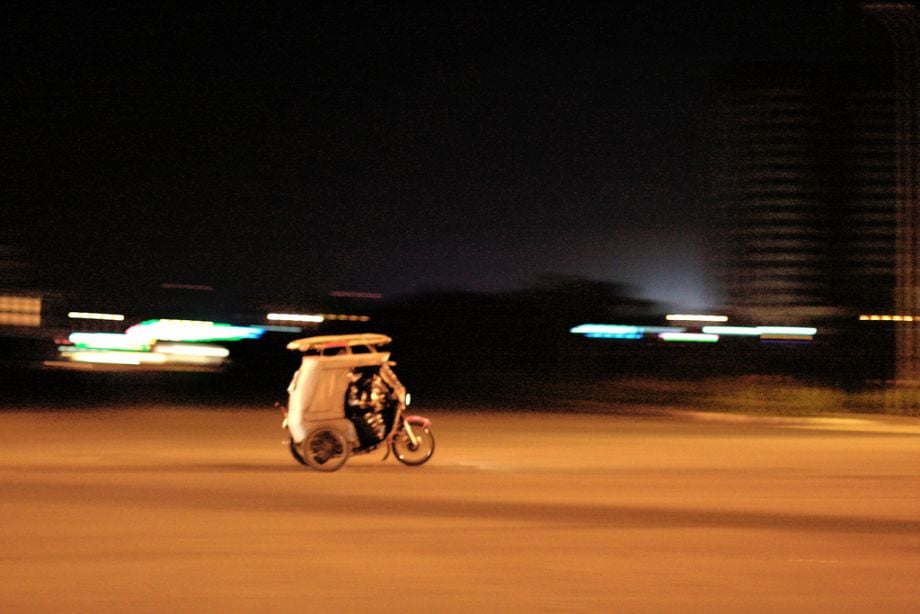There are 3.5 million tricycles in the Philippines, and they’re mostly ridden by adults. Conventional motorbikes with metal passenger sidecars welded to their sides, the trikes are one of the many quirky aspects of public life here that delight tourists and, for locals, provide the bulk of public transportation in provincial cities across the country.
They’re also loud and dirty, roaring through the streets and spewing black smoke from rattling tailpipes. But the ubiquitous Manilan tricycle may soon get a makeover. In March the Philippine government, in partnership with the Asian Development Bank (ADB) and backed by Meralco, the country’s electricity monopoly, announced the first stages of a 505.6 million pesos ($11 million) project that would put 100,000 electric tricycles on the streets of Manila and other provinces by 2017.
With silent, no-emission engines, the fleet of e-bikes would cut down on noise pollution and reduce the amount of carbon dioxide released into the atmosphere by an estimated 260,000 tons per year. According to an ADB study, electric-powered tricycles would also reduce dependence on foreign fuel and cut operating costs for tricycle drivers by up to 60 percent. With strong government backing and eager private-sector support, the program could turn the Philippines into a regional hub for electric public transportation.
The proposal seems like a solid win for the environment, and an opportunity for the country to poise itself as a leader in sustainable transport. But the project has some detractors, including what would seem like some natural allies: environmentalists.
Red Constantino, executive director for the Institute for Climate and Sustainable Cities, says the e-tricycle program “sustains the prevailing chaos rather than helping rationalize transport in the country.” Tricycles are single-serving public transport, inefficiently carrying one passenger from door to door, and money would be better spent supporting larger vehicles that can transport people en masse, like buses or the country’s iconic jeepneys.
What’s more, the Philippines already has some of the highest electricity-usage rates in Asia, and Constantino points out that energy crises have become common in parts of the country. Pouring resources into an EV program could make the problem even worse, and distract from the more fundamental challenge of creating stable sources of renewable energy.
The electric tricycles will run on rechargeable lithium ion batteries, the same technology that powers smart phones and laptops, which, as any aging-iPhone owner knows, gets sluggish after just a few years. Currently there’s no viable aftercare support for lithium ion batteries in the Philippines, nor in Europe, Japan or the United States. Constantino says to suggest that the Philippines will simply come up with a system to address the long-term shortfalls of battery technology “is just silly.”

Advocates say the new e-trikes will cut down on pollution, but they may cause other problems. Photo credit: ETrike Vehicle via Facebook
He’s also wary of some details of the project’s implementation. For instance, rather than working directly with tricycle drivers and fleet owners, the ADB project will collaborate with local government units, not known for their squeaky-clean reputations. Subsidized credit also distorts the market for electric vehicles, and imposing a single electric tricycle design — irrespective of terrain, road quality or passenger demand — across the vastly varying landscape of the Philippines doesn’t make sense.
In essence, Constantino worries that what could be hailed as an innovative leap forward in sustainable transport might actually be greenwashing. “Just because it’s electric it doesn’t mean it has to be supported,” he says.
While the Philippine government and the division of the ADB in charge of the program are pushing electric trikes, Ko Sakamoto, a transport economist for the ADB has a more tempered view of what the e-bikes can do for the region. “We’d like to avoid the notion that e-vehicles are the solution to everything,” says Sakamoto.
Supporting cleaner energy is part of the ADB’s sustainable transport goals, according to Sakamoto. However, he says, “We do not advocate as an institution one energy type over another.” He points out alternatives, like Thailand’s tuktuks, some of which have switched to clean natural gas, a cheaper technology than electric engines.
Electric tricycles may contribute to solving certain problems like air pollution and climate change, but could inadvertently make other problems worse, like congestion. “There needs to be a fundamental change in the way cities are built,” Sakamoto says. Which means planning cities that reduce the need for unnecessary transport — two-hour-long commutes, for example — and shifting to more sustainable modes of transport, like biking and walking.
“The project is still in its early stages, and we don’t want to overstate the possibility,” Sakamoto says. Despite the draw of the quick-fix and the enthusiasm in some circles for e-bikes, at most they are one piece of a longer climb to making Manila’s transportation infrastructure genuinely clean and sustainable.





_600_350_80_s_c1.jpg)











